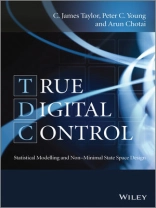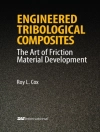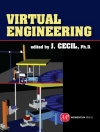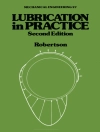True Digital Control: Statistical Modelling and Non–Minimal State Space Designdevelops a true digital control design philosophy that encompasses data–based model identification, through to control algorithm design, robustness evaluation and implementation. With a heritage from both classical and modern control system synthesis, this book is supported by detailed practical examples based on the authors’ research into environmental, mechatronic and robotic systems. Treatment of both statistical modelling and control design under one cover is unusual and highlights the important connections between these disciplines.
Starting from the ubiquitous proportional–integral controller, and with essential concepts such as pole assignment introduced using straightforward algebra and block diagrams, this book addresses the needs of those students, researchers and engineers, who would like to advance their knowledge of control theory and practice into the state space domain; and academics who are interested to learn more about non–minimal state variable feedback control systems. Such non–minimal state feedback is utilised as a unifying framework for generalised digital control system design. This approach provides a gentle learning curve, from which potentially difficult topics, such as optimal, stochastic and multivariable control, can be introduced and assimilated in an interesting and straightforward manner.
Key features:
- Covers both system identification and control system design in a unified manner
- Includes practical design case studies and simulation examples
- Considers recent research into time–variable and state–dependent parameter modelling and control, essential elements of adaptive and nonlinear control system design, and the delta–operator (the discrete–time equivalent of the differential operator) systems
- Accompanied by a website hosting MATLAB examples
True Digital Control: Statistical Modelling and Non–Minimal State Space Design is a comprehensive and practical guide for students and professionals who wish to further their knowledge in the areas of modern control and system identification.
表中的内容
Preface xiii
List of Acronyms xv
List of Examples, Theorems and Estimation Algorithms xix
1 Introduction 1
1.1 Control Engineering and Control Theory 2
1.2 Classical and Modern Control 5
1.3 The Evolution of the NMSS Model Form 8
1.4 True Digital Control 11
1.5 Book Outline 12
1.6 Concluding Remarks 13
References 14
2 Discrete-Time Transfer Functions 17
2.1 Discrete-Time TF Models 18
2.1.1 The Backward Shift Operator 18
2.1.2 General Discrete-Time TF Model 22
2.1.3 Steady-State Gain 23
2.2 Stability and the Unit Circle 24
2.3 Block Diagram Analysis 26
2.4 Discrete-Time Control 28
2.5 Continuous to Discrete-Time TF Model Conversion 36
2.6 Concluding Remarks 38
References 38
3 Minimal State Variable Feedback 41
3.1 Controllable Canonical Form 44
3.1.1 State Variable Feedback for the General TF Model 49
3.2 Observable Canonical Form 50
3.3 General State Space Form 53
3.3.1 Transfer Function Form of a State Space Model 53
3.3.2 The Characteristic Equation, Eigenvalues and Eigenvectors 55
3.3.3 The Diagonal Form of a State Space Model 57
3.4 Controllability and Observability 58
3.4.1 Definition of Controllability (or Reachability) 58
3.4.2 Rank Test for Controllability 59
3.4.3 Definition of Observability 59
3.4.4 Rank Test for Observability 59
3.5 Concluding Remarks 61
References 62
4 Non-Minimal State Variable Feedback 63
4.1 The NMSS Form 64
4.1.1 The NMSS (Regulator) Representation 64
4.1.2 The Characteristic Polynomial of the NMSS Model 67
4.2 Controllability of the NMSS Model 68
4.3 The Unity Gain NMSS Regulator 69
4.3.1 The General Unity Gain NMSS Regulator 74
4.4 Constrained NMSS Control and Transformations 77
4.4.1 Non-Minimal State Space Design Constrained to yield a Minimal SVF Controller 79
4.5 Worked Example with Model Mismatch 81
4.6 Concluding Remarks 85
References 86
5 True Digital Control for Univariate Systems 89
5.1 The NMSS Servomechanism Representation 93
5.1.1 Characteristic Polynomial of the NMSS Servomechanism Model 95
5.2 Proportional-Integral-Plus Control 98
5.2.1 The Closed-Loop Transfer Function 99
5.3 Pole Assignment for PIP Control 101
5.3.1 State Space Derivation 101
5.4 Optimal Design for PIP Control 110
5.4.1 Linear Quadratic Weighting Matrices 111
5.4.2 The LQ Closed-loop System and Solution of the Riccati Equation 112
5.4.3 Recursive Solution of the Discrete-Time Matrix Riccati Equation 114
5.5 Case Studies 116
5.6 Concluding Remarks 119
References 120
6 Control Structures and Interpretations 123
6.1 Feedback and Forward Path PIP Control Structures 123
6.1.1 Proportional-Integral-Plus Control in Forward Path Form 125
6.1.2 Closed-loop TF for Forward Path PIP Control 126
6.1.3 Closed-loop Behaviour and Robustness 127
6.2 Incremental Forms for Practical Implementation 131
6.2.1 Incremental Form for Feedback PIP Control 131
6.2.2 Incremental Form for Forward Path PIP Control 134
6.3 The Smith Predictor and its Relationship with PIP Design 137
6.3.1 Relationship between PIP and SP-PIP Control Gains 139
6.3.2 Complete Equivalence of the SP-PIP and Forward Path PIP Controllers 140
6.4 Stochastic Optimal PIP Design 142
6.4.1 Stochastic NMSS Equations and the Kalman Filter 142
6.4.2 Polynomial Implementation of the Kalman Filter 144
6.4.3 Stochastic Closed-loop System 149
6.4.4 Other Stochastic Control Structures 150
6.4.5 Modified Kalman Filter for Non-Stationary Disturbances 151
6.4.6 Stochastic PIP Control using a Risk Sensitive Criterion 152
6.5 Generalised NMSS Design 153
6.5.1 Feed-forward PIP Control based on an Extended Servomechanism NMSS Model 153
6.5.2 Command Anticipation based on an Extended Servomechanism NMSS Model 154
6.6 Model Predictive Control 157
6.6.1 Model Predictive Control based on NMSS Models 158
6.6.2 Generalised Predictive Control 158
6.6.3 Equivalence Between GPC and PIP Control 159
6.6.4 Observer Filters 162
6.7 Concluding Remarks 163
References 164
7 True Digital Control for Multivariable Systems 167
7.1 The Multivariable NMSS (Servomechanism) Representation 168
7.1.1 The General Multivariable System Description 170
7.1.2 Multivariable NMSS Form 171
7.1.3 The Characteristic Polynomial of the Multivariable NMSS Model 173
7.2 Multivariable PIP Control 175
7.3 Optimal Design for Multivariable PIP Control 177
7.4 Multi-Objective Optimization for PIP Control 186
7.4.1 Goal Attainment 187
7.5 Proportional-Integral-Plus Decoupling Control by Algebraic Pole Assignment 192
7.5.1 Decoupling Algorithm I 193
7.5.2 Implementation Form 194
7.5.3 Decoupling Algorithm II 195
7.6 Concluding Remarks 195
References 196
8 Data-Based Identification and Estimation of Transfer Function Models 199
8.1 Linear Least Squares, ARX and Finite Impulse Response Models 200
8.1.1 En bloc LLS Estimation 202
8.1.2 Recursive LLS Estimation 203
8.1.3 Statistical Properties of the RLS Algorithm 205
8.1.4 The FIR Model 210
8.2 General TF Models 211
8.2.1 The Box–Jenkins and ARMAX Models 212
8.2.2 A Brief Review of TF Estimation Algorithms 213
8.2.3 Standard IV Estimation 215
8.3 Optimal RIV Estimation 218
8.3.1 Initial Motivation for RIV Estimation 218
8.3.2 The RIV Algorithm in the Context of ml 220
8.3.3 Simple AR Noise Model Estimation 222
8.3.4 RIVAR Estimation: RIV with Simple AR Noise Model Estimation 223
8.3.5 Additional RIV Algorithms 226
8.3.6 RIVAR and IV4 Estimation Algorithms 227
8.4 Model Structure Identification and Statistical Diagnosis 231
8.4.1 Identification Criteria 232
8.4.2 Model Structure Identification Procedure 234
8.5 Multivariable Models 243
8.5.1 The Common Denominator Polynomial MISO Model 243
8.5.2 The MISO Model with Different Denominator Polynomials 246
8.6 Continuous-Time Models 248
8.6.1 The SRIV and RIVBJ Algorithms for Continuous-Time Models 249
8.6.2 Estimation of δ-Operator Models 253
8.7 Identification and Estimation in the Closed-Loop 253
8.7.1 The Generalised Box−Jenkins Model in a Closed-Loop Context 254
8.7.2 Two-Stage Closed-Loop Estimation 255
8.7.3 Three-Stage Closed-Loop Estimation 256
8.7.4 Unstable Systems 260
8.8 Concluding Remarks 260
References 261
9 Additional Topics 265
9.1 The δ-Operator Model and PIP Control 266
9.1.1 The δ-operator NMSS Representation 267
9.1.2 Characteristic Polynomial and Controllability 268
9.1.3 The δ-Operator PIP Control Law 269
9.1.4 Implementation Structures for δ-Operator PIP Control 270
9.1.5 Pole Assignment δ-Operator PIP Design 271
9.1.6 Linear Quadratic Optimal δ-Operator PIP Design 272
9.2 Time Variable Parameter Estimation 279
9.2.1 Simple Limited Memory Algorithms 281
9.2.2 Modelling the Parameter Variations 282
9.2.3 State Space Model for DTF Estimation 284
9.2.4 Optimisation of the Hyper-parameters 287
9.3 State-Dependent Parameter Modelling and PIP Control 290
9.3.1 The SDP-TF Model 290
9.3.2 State-Dependent Parameter Model Identification and Estimation 292
9.3.3 Proportional-Integral-Plus Control of SDP Modelled Systems 293
9.4 Concluding Remarks 298
References 298
Appendix A Matrices and Matrix Algebra 301
A. 1 Matrices 301
A. 2 Vectors 302
A. 3 Matrix Addition (or Subtraction) 302
A. 4 Matrix or Vector Transpose 302
A. 5 Matrix Multiplication 303
A. 6 Determinant of a Matrix 304
A. 7 Partitioned Matrices 305
A. 8 Inverse of a Matrix 306
A. 9 Quadratic Forms 307
A. 10 Positive Definite or Semi-Definite Matrices 308
A. 11 The Rank of a Matrix 308
A. 12 Differentiation of Vectors and Matrices 308
References 310
Appendix B The Time Constant 311
Reference 311
Appendix C Proof of Theorem 4.1 313
References 314
Appendix D Derivative Action Form of the Controller 315
Appendix E Block Diagram Derivation of PIP Pole Placement Algorithm 317
Appendix F Proof of Theorem 6.1 321
Reference 322
Appendix G The CAPTAIN Toolbox 323
G. 1 Transfer Functions and Control System Design 323
G. 2 Other Routines 324
G. 3 Download 325
References 325
Appendix H The Theorem of D.A. Pierce (1972) 327
References 328
Index 329
关于作者
James Taylor received his B.Sc. (Hons.) and Ph.D degrees from Lancaster University, UK, before joining the academic staff of the Engineering Department in 2000. His research focuses on control system design and system identification, with applied work spanning robotics, transport, energy, agriculture and the environment. This has led to over 100 publications in the open literature and widespread impact across a variety of academic and industry–based users. He has pioneered new advances in non–minimal state space design, and coordinates development of the well–known Captain Toolbox for Time Series Analysis and Forecasting. He is a Fellow of the Institution of Engineering and Technology, and supervises students across a spectrum of mechanical, electronic, nuclear and chemical engineering disciplines.
Peter Young is Emeritus Professor at Lancaster University, UK, and Adjunct Professor at the Australian National University, Canberra. After an apprenticeship in the Aerospace Industry and B.Tech., MSc. degrees from Loughborough University, he obtained his Ph.D degree from Cambridge University in 1970 and became University Lecturer in Engineering and a Fellow of Clare Hall at Cambridge University. After seven years as Professorial Fellow at the Australian National University, he then moved to Lancaster University in 1981 as Professor and Head of the Environmental Science Department. He is well known for his work on optimal identification, data–based mechanistic modelling and adaptive forecasting, with applications in areas ranging from the environment, through ecology, biology and engineering to business and macro–economics.
Until his recent retirement, Arun Chotai was Senior Lecturer in the Lancaster Environment Centre at Lancaster University, UK. He holds a Ph.D in Systems and Control and a B.Sc. (Hons.) in Mathematics, both from the University of Bath, UK. Following his appointment to an academic position at Lancaster in 1984, he taught and developed modules in environmental systems, courses that were then unique to the UK in providing an advanced, quantitative approach to the subject. For many years, he was also joint head (with present co–author Peter Young) of the Systems and Control Group, which he helped to build into a successful research unit that became known internationally for its research in the areas of system identification, time–series analysis and control system design.












